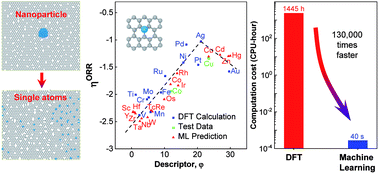Rational design of transition metal single-atom electrocatalysts: a simulation-based, machine learning-accelerated study†
Abstract
With maximum atom-utilization efficiency, single atom catalysts (SACs) are surging as a new research frontier in catalysis science. However, fabricating SACs and maintaining their thermodynamic stability remain challenging and thus uneconomical, largely due to the lack of fundamental understanding of the formation and stabilization mechanisms of single atoms (SAs). Through systematic density functional theory (DFT) calculations and machine learning algorithms, we present a rational design guidance for the feasibility of transition metal SA formation on a defective carbon surface and the oxygen reduction reaction (ORR) activity of the resulting SAs. We show that the dispersion of a metal nanoparticle (NP) into a stable array of SAs on a defective carbon surface is governed by the decomposition energy barrier of the NP and the diffusion barrier of SAs on a carbon surface. An intrinsic descriptor that correlates the catalytic activity of a SAC with the topological, bonding, and electronic structures of the SAC and its bonding carbon defect site is revealed. The few-shot machine learning algorithm further enables a 130 000-fold reduction of the time needed to calculate the ORR activity of SACs from DFT, and thus allows us to predict the ORR activity of SACs of all transition metals within an error of 8.33%. The results from this study offer a mechanistic and quantitative guidance for rational selection of transition metal and optimal synthesis conditions to fabricate SACs with desirable electrocatalyst activity in emerging energy applications.

- This article is part of the themed collection: Editor’s Choice: Machine Learning for Materials Innovation


 Please wait while we load your content...
Please wait while we load your content...